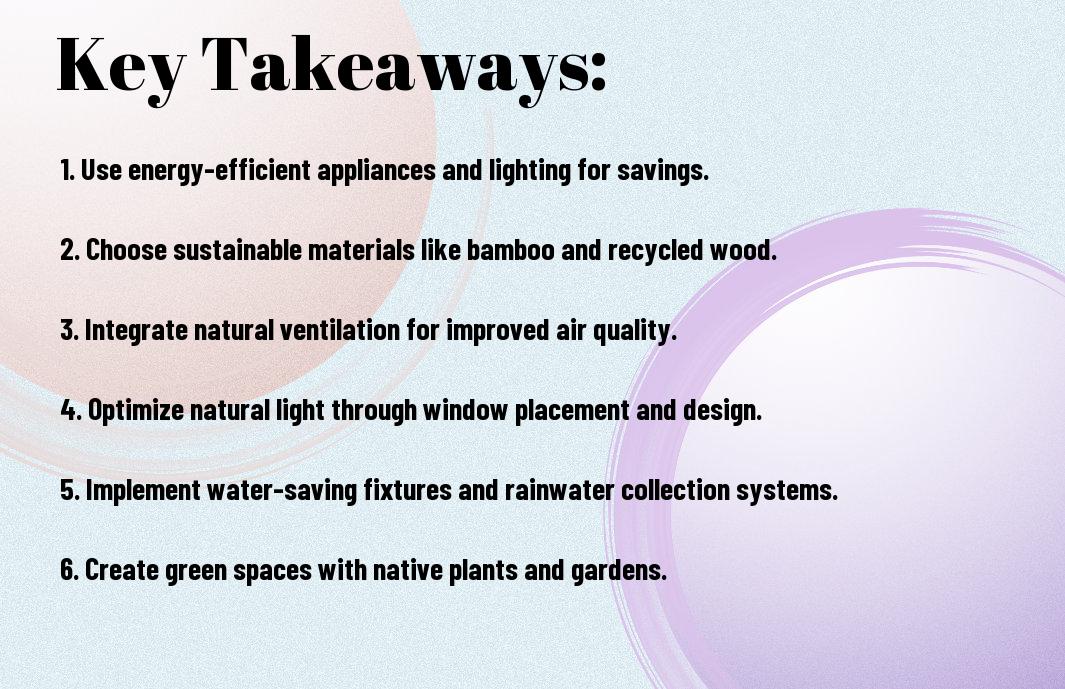You’re building or renovating your home, and you want it to be more than just a shelter – you want it to be eco-friendly. Your home’s design can significantly impact the environment, and making sustainable choices can have a lasting effect. You can start by considering your daily habits and how your home’s layout can support a greener lifestyle. By incorporating sustainable practices into your design, you can reduce your carbon footprint and create a healthier living space for yourself and your family.
Key Takeaways:
To create an eco-friendly home, consider the following key points:
- Use renewable materials in your design, such as bamboo or reclaimed wood, to reduce the environmental impact of your home construction.
- Incorporate energy-efficient systems, including solar panels and rainwater harvesting, to reduce your reliance on non-renewable energy sources and lower your utility bills.
- Implement sustainable design principles, such as natural ventilation and passive heating, to minimize your home’s carbon footprint and create a healthier living space.

Principles
Before you start designing your home, consider the principles of sustainable design. You’ll want to focus on reducing your environmental footprint, conserving resources, and creating a healthy living space. Your goal is to strike a balance between aesthetics and eco-friendliness.
Embracing Eco-Friendly Materials
With a thoughtful approach, you can choose materials that are gentle on the planet. You’ll look for materials that are sustainable, recycled, or locally sourced, reducing the demand on natural resources and minimizing waste.
Optimizing Natural Light and Ventilation
By designing your home to maximize natural light and ventilation, you can reduce your reliance on artificial lighting and heating and cooling systems. You’ll position windows and doors to capture natural light and breeze, creating a comfortable and healthy living space.
Plus, when you optimize natural light and ventilation, you can also reduce your energy consumption and lower your utility bills. You’ll feel the benefits of a well-designed home, from the natural light pouring in to the fresh air circulating throughout, creating a sense of well-being and connection to the outdoors.
Design
It starts with your design, where you can find inspiration from resources like Eco-Friendly Living: Sustainable Home Design Tips and Ideas to create a space that is both functional and environmentally friendly.
Sustainable Layout and Space Planning
Sensibly, you’ll want to consider a layout that maximizes natural light and reduces waste, making the most of your space while minimizing your environmental footprint.
Incorporating Recycled and Reclaimed Materials
By incorporating eco-friendly materials, you can reduce your impact on the environment and create a unique, character-filled space that reflects your values.
Plus, using recycled and reclaimed materials can add a touch of warmth and personality to your design, making your space feel truly one-of-a-kind, and you can explore various options, such as reclaimed wood, low-VOC paints, and sustainable flooring, to create a space that is both beautiful and eco-friendly.
Energy Efficiency
After considering your home’s design, you’ll want to focus on energy efficiency to minimize your environmental impact. You can achieve this by optimizing your home’s insulation, windows, and doors to reduce heat loss and gain.
Renewable Energy Sources and Systems
To effectively incorporate sustainable practices, you’ll need to explore renewable energy sources and systems, such as solar or wind power, to reduce your reliance on non-renewable energy sources.
Energy-Saving Appliances and Lighting
Renergizing your approach to home design, you’ll want to select energy-saving appliances and lighting to minimize your energy consumption, such as LED bulbs and energy-efficient refrigerators.
It is important to choose appliances with high energy ratings and consider smart home devices to optimize your energy usage, allowing you to monitor and control your energy consumption, making your home more sustainable and environmentally friendly, which will help you to reduce your carbon footprint and save on your energy bills.
Water Conservation
Once again, you’ll find that incorporating sustainable practices into your home design has its benefits, and for more information on this, you can visit sustainable design resources. You’ll learn how to reduce your water consumption.
Low-Flow Fixtures and Greywater Systems
Any homeowner can install low-flow fixtures and greywater systems to reduce water waste, and you’re no exception. You can start by replacing old faucets and toilets with low-flow models.
Rainwater Harvesting and Storage
After assessing your water needs, you can consider installing a rainwater harvesting system. You’ll be able to collect and reuse rainwater for non-potable purposes.
Storage is key when it comes to rainwater harvesting. You’ll need to invest in a suitable tank to store the collected water, and consider factors like size, material, and placement to ensure your system runs efficiently. You’ll be surprised at how much you can save on your water bill by implementing this simple yet effective system in your home.
Indoor Air Quality
Keep your home’s air clean by incorporating sustainable practices into your design. This includes using natural ventilation, air purification systems, and non-toxic materials.
Natural Ventilation and Air Purification
Naturally, a well-ventilated home is necessary for good air quality. You can achieve this by installing windows, vents, and fans that promote air circulation and bring in fresh air from outside.
Non-Toxic and Low-VOC Materials
To ensure your home’s air stays clean, you should choose materials with low VOCs (volatile organic compounds). You can look for products labeled as non-toxic and eco-friendly.
This approach will help you create a healthier indoor environment. You can opt for natural materials like wood, bamboo, and wool, which are known for their low VOC emissions. By making these choices, you’ll be able to breathe easier in your own home.
Maintenance and Upkeep
Your home’s sustainability depends on regular maintenance, learn more about The Key Elements of a Sustainable House Design to ensure your space remains eco-friendly.
Sustainable Cleaning and Maintenance Practices
Any measures you take to maintain your home’s sustainability will pay off in the long run, using eco-friendly cleaning products and repurposing materials will reduce waste and minimize your environmental footprint.
Regular Inspections and Repairs
Against all odds, your sustainable home will thrive with regular inspections, checking for leaks, and repairing damaged systems to prevent further issues.
Another key aspect of regular inspections is identifying areas where you can improve energy efficiency, such as sealing air leaks or upgrading to energy-efficient appliances, allowing you to make adjustments and maintain your home’s sustainability over time.

Conclusion
Ultimately, you can make a significant impact on the environment by incorporating sustainable practices in your home design. You’ll reduce your carbon footprint and create a healthier living space by using eco-friendly materials, minimizing waste, and optimizing energy efficiency. Your efforts will benefit both your well-being and the planet, making your home a haven for years to come.
FAQ
Q: What are the benefits of incorporating sustainable practices in home design?
A: Incorporating sustainable practices in home design offers numerous benefits, including reduced energy consumption, lower utility bills, and a minimized carbon footprint. Sustainable design can also improve indoor air quality, enhance natural lighting, and create a healthier living environment. Additionally, sustainable homes can increase property value and appeal to environmentally conscious buyers if you decide to sell in the future.
Q: How can I reduce energy consumption through sustainable home design?
A: To reduce energy consumption, consider incorporating features such as solar panels, energy-efficient windows, and insulation into your home design. You can also optimize natural lighting by strategically placing windows and skylights, reducing the need for artificial lighting. Furthermore, installing energy-efficient appliances and lighting fixtures, such as LED bulbs, can significantly decrease energy consumption. Smart home technology can also help monitor and control energy usage, allowing you to make data-driven decisions to minimize waste.
Q: What materials should I use for sustainable home construction?
A: Concerning sustainable home construction, it’s important to choose materials that are environmentally friendly, durable, and require minimal maintenance. Consider using reclaimed or recycled materials, such as reclaimed wood, bamboo, or low-VOC (volatile organic compound) paints. Sustainable materials like low-carbon concrete, sustainably sourced wood, and recycled glass can also reduce the environmental impact of your home. Additionally, look for materials with certifications like FSC (Forest Stewardship Council) or Greenguard Gold, which ensure that the materials meet rigorous sustainability standards.
Q: How can I incorporate water conservation into my home design?
A: To incorporate water conservation into your home design, consider installing low-flow fixtures, such as faucets, showerheads, and toilets. You can also implement a rainwater harvesting system to collect and reuse rainwater for irrigation, toilet flushing, or washing machines. Greywater systems, which reuse wastewater from sinks, showers, and washing machines, can also significantly reduce water consumption. Furthermore, choosing drought-resistant plants and implementing efficient irrigation systems can minimize outdoor water usage.
Q: Are there any government incentives for incorporating sustainable practices in home design?
A: Yes, there are various government incentives for incorporating sustainable practices in home design. Many governments offer tax credits, rebates, or grants for homeowners who invest in energy-efficient appliances, solar panels, or other sustainable features. Additionally, some governments have programs that provide low-interest loans or financing options for sustainable home upgrades. It’s important to research and explore the specific incentives available in your area, as they can help offset the costs of sustainable design and construction. Be sure to consult with a tax professional or sustainable design expert to ensure you’re taking advantage of all the incentives available to you.





